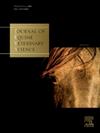A single session of whole-body vibration did not affect cardiovascular autonomic recovery after a high intensity exercise in horses
IF 1.6
3区 农林科学
Q2 VETERINARY SCIENCES
引用次数: 0
Abstract
Background
Whole-body vibration (WBV) has the potential to enhance post-exercise recovery in humans. Heart rate variability (HRV), a well-established biomarker of cardiac autonomic regulation (CAR), provides insight into autonomic reactivity during recovery from exercise.
Aim
To investigate CAR in healthy horses during post-exercise recovery following an acute intensive exercise bout (AIEB) with WBV intervention.
Methods
A single AIEB was prescribed at velocities corresponding to lactate threshold (VLT), and the eight horses performed on treadmill with 5 % slope, 2 min at 110 % VLT followed by 3 min at 130 % VLT. Three 10-minute recovery protocols were compared: treadmill walking (TG), switched-off platform sham group (SG), and whole-body vibration (WBVG) at 76, 66, 55, 46, and 32 Hz for 2 minutes each. HR and HRV, time and frequency domains, were monitored throughout recovery. K-means clustering identified HR/HRV-based profiles and the variables were analyzed via two-way repeated measures.
Results
The dendrogram indicated that the time points were distinct, with a spatial separation between the baseline and post-exercise phases, regardless of the recovery strategy employed. These findings suggest that the positive chronotropic effect induced by AIEB effectively distinguished the horses' responses. During recovery, HRV measures did not differ among strategies. The TG maintained a higher HR (P < 0.001) and shorter mean RR interval (P < 0.001) relative to SG and WBVG, reflecting sustained cardiac sympathetic activation.
Conclusion
Within the parameters of this study, WBV recovery did not influence post-exercise cardiac autonomic modulation in horses. WBV did not enhance parasympathetic reactivation or cardio-deceleration post-exercise in horses.
单次全身振动不影响马在高强度运动后的心血管自主神经恢复。
背景:全身振动(WBV)具有增强人类运动后恢复的潜力。心率变异性(HRV)是一种公认的心脏自主调节(CAR)的生物标志物,可以深入了解运动恢复过程中的自主反应性。目的:研究在WBV干预下,健康马在急性高强度运动(AIEB)后运动后恢复过程中的CAR。方法:以与乳酸阈值(VLT)相对应的速度进行单次AIEB, 8匹马在坡度为5%的跑步机上进行,在110% VLT下进行2分钟,在130% VLT下进行3分钟。比较了三种10分钟恢复方案:跑步机步行(TG)、关闭平台(SG)和全身振动(WBVG),每种2分钟,频率分别为76、66、55、46和32 Hz。在整个恢复过程中监测HR和HRV的时域和频域。K-means聚类确定了基于HR/ hrv的概况,并通过双向重复测量分析了变量。结果:无论采用何种恢复策略,树状图显示时间点不同,基线和运动后阶段之间存在空间分离。这些结果表明,AIEB诱导的正变时效应有效地区分了马的反应。在恢复期间,不同策略的HRV测量没有差异。与SG和WBVG相比,TG保持较高的HR (P < 0.001)和较短的平均RR间隔(P < 0.001),反映了心脏交感神经持续激活。结论:在本研究的参数范围内,马的WBV恢复不影响运动后心脏自主调节。WBV不增强马运动后的副交感神经再激活或心脏减速。
本文章由计算机程序翻译,如有差异,请以英文原文为准。
求助全文
约1分钟内获得全文
求助全文
来源期刊

Journal of Equine Veterinary Science
农林科学-兽医学
CiteScore
2.70
自引率
7.70%
发文量
249
审稿时长
77 days
期刊介绍:
Journal of Equine Veterinary Science (JEVS) is an international publication designed for the practicing equine veterinarian, equine researcher, and other equine health care specialist. Published monthly, each issue of JEVS includes original research, reviews, case reports, short communications, and clinical techniques from leaders in the equine veterinary field, covering such topics as laminitis, reproduction, infectious disease, parasitology, behavior, podology, internal medicine, surgery and nutrition.
 求助内容:
求助内容: 应助结果提醒方式:
应助结果提醒方式:


